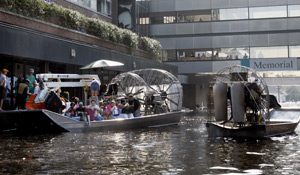“We shape our buildings; thereafter, they shape usâ€
– Winston Churchill.
The American Institute of Architects (AIA) Healthcare Design and Construction Guidelines for Healthcare Facilities are generally accepted as the nation’s “BIBLE†for the Design and Construction of Healthcare Facilities. Motto ?
“Having the Courage and Wisdom to adopt requirements that are forward looking and address the needs of the future, looking backwards only to discover what not to doâ€.
Prior to 1987 the guidelines were published by the Department of Health and Human Services (DHHS) and its predecessor organizations back to the Hill-Burton Period. During the threatening cold-war era, the guidelines were targeted to reflect changes associated with geo-political and other hostile variations in the environment.
The post-cold war strategy for homeland security protection has its roots in the concern that the feared weapons of mass destructions (WMD) may well fall into the hands of known and yet unknown non-state terrorists. Many date the post-cold war threat to the Healthcare Industry with President Reagan’s November 1988 Executive Order 12656: Assignment of Emergency Preparedness Responsibly. The Department of Health and Human Services (DHHS) was tasked with the development of a comprehensive national plan to mobilize the nation’s healthcare Industry to meet the challenges posed by these emerging threats, to include mitigate known vulnerabilities to the infrastructure.
 A decade later, Presidential Decision Directive PDD-63 released in May 1998 was a call to action to protect the nation’s critical Infrastructure. Post 9/11 PDD-63 was superseded (December 2003) by Homeland Security Presidential Directive-7 (HSPD-7) directing the new Department of Homeland Security (DHS) to develop a National Infrastructure Protection Plan (NIPP).
A decade later, Presidential Decision Directive PDD-63 released in May 1998 was a call to action to protect the nation’s critical Infrastructure. Post 9/11 PDD-63 was superseded (December 2003) by Homeland Security Presidential Directive-7 (HSPD-7) directing the new Department of Homeland Security (DHS) to develop a National Infrastructure Protection Plan (NIPP).
The core NIPP objectives are: 1) Protect our nation from Dangerous People 2) Protect our nation from Dangerous Goods 3) Protect Critical Infrastructure 4) Build a nimble, effective Emergency Management System and a Culture of Preparedness 5) Strengthen and Unify DHS Operations and Management.
The Department of Homeland Security tasked the DHHS with the responsibility for Healthcare and Public Health Sector and the Sector-Specific Plan (HHP-SSP) NIPP implementation. The initial DHS NIPP handoff to DHHS proved to be challenging and is and has been characterized as the “weakest link in the Homeland Security chainâ€.
The initial federal effort toward designing and constructing new healthcare facilities and retrofitting existing structures to reduce the harmful effects of known hazards, reinforced by evolving “best practices and lessons learnedâ€, have contributed to a significant improvement in the workplace protection for current and future federal healthcare workers and other stakeholders.
The non-federal healthcare sector has not followed the federal sector’s lead to mitigate vulnerabilities associated with known hazards through design, construction and retrofitting of their facilities, and for the most part, have not taken advantage of lessons learned and best practices that were diligently adopted by the federal sector.
The dual benefits of constructing/retrofitting more robust healthcare facilities which protect against Chemical, Biological, Radiological, Nuclear and Explosives (with or without radioactive materials) WMD, also protects against increasingly severe natural disasters and evolving infectious diseases.
Many of us in the all-hazards readiness business gave the 2002 HGRC group a provisional pass based on the proximity of the 9/11 attacks.  The lapses in the 2006 AIA guidance caught us by surprise as we had been assured by the industry leadership that the new edition would reflect “real world†concerns for known looming threats. We were stunned by the lack of response for recent evidence-based threats – First Tower attack, Oklahoma City bombing, 9/11, Tropical Storm Allison, Katrina etc.
The 2006 AIA document reflected a passive “business as usual†guidance and remained silent on the fundamental changes necessary to protect all healthcare stakeholders exposed to an increasingly dangerous environment.
Influential segments of the healthcare industry have done little to advocate for, or facilitate a realistic movement, toward a non-federal healthcare partnership in the National Response Framework. This attitude of apathy and denial for a meaningful partnership in the Nation’s Strategy for Healthcare Homeland Security readiness/protection is clearly seen in major segments of the sector.
It appears that the hospital and healthcare building industry was and is existing on some parallel universe not unlike the old Superman Comic’s “Bizarro World”, i.e., everything is the reverse of what is should be. Unfortunately they have a host of enablers to resist obviously needed areas of improvement, including CMS-contracted external evaluation entities, all levels of oversight and industry trade organizations.
Members of the healthcare media who found these patient care sites with great glass domes and access to gardens and windows bringing nature to the bedside worthy of grand prize winners on the healthcare landscape. One article heaped praise on the patient designed free-standing cancer center which failed to protect from many known hazards, including what the Defense Science Board identified in 2007 as the “low hanging fruit†of the dreaded “Dirty Bombâ€.
Subsequent to the 2006 edition, we spent two weeks reviewing the document and talking with key contributors to the report. These conversations brought more heat than light. Dozens of calls were made to Federal Agency authorities in an attempt to see who had signed off on the document. Seeking information on who reviewed it within The Department of Homeland Security convinced us that “no one had seen the document†let alone reviewed it.
 Assurances that our concerns would be addressed in the 2010 guidance gave us little comfort, it was 2006 and a lot could happen before 2010. Fast forward to 2010 to say we were disappointed is the understatement of the decade. The document still contained wording to the effect, I paraphrase, “controlling access to treatment facilities is difficult to impossible and undesirableâ€.
Assurances that our concerns would be addressed in the 2010 guidance gave us little comfort, it was 2006 and a lot could happen before 2010. Fast forward to 2010 to say we were disappointed is the understatement of the decade. The document still contained wording to the effect, I paraphrase, “controlling access to treatment facilities is difficult to impossible and undesirableâ€.
We failed to process the 2006 official answer and should have known little would change. The correspondence from us (AIA 2007 Letter) on the issue garnered a worrisome response when looking from the outside in, in part; it read
“We would like to state that all 125 committee members are dedicated to making the Guidelines for Design and Construction of Healthcare Facilities a top-notch set of recommended standards..There is not a person on the committee that has intentionally tried to keep any effort to add language for hardening our healthcare buildings out of our guidelinesâ€.
We posit that a lot of committee members representing federal agencies failed their duty. We again tried, without success, to find any evidence the Department of Homeland Security had been involved in the process.
We return to “Having the Courage and Wisdom to adopt requirements that are forward looking and address the needs of the future, looking backwards only to discover what not to doâ€.
We find little to support the statement, no profiles in courage, questionable judgment and a self-absorbed vision of the future.
We are left with the question, has the practice of passing critical oversight responsibility from Federal Agencies to Trade Organizations served the public good?





0 Comments